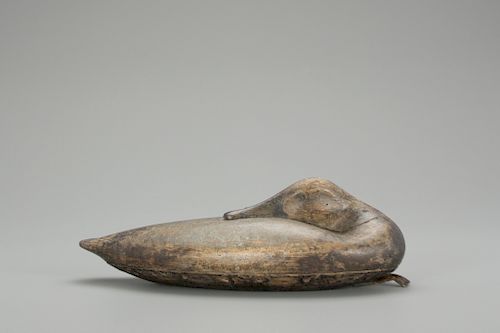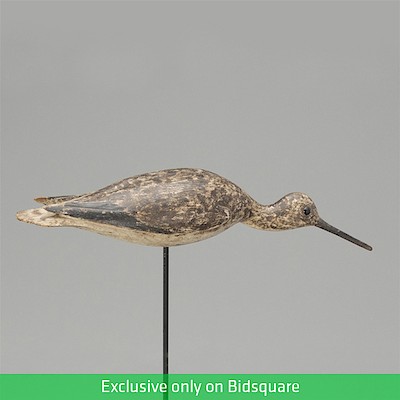Sleeping Canvasback Hen, Albert Davids Laing (1811-1886)
Lot 255
About Seller
Copley Fine Art Auctions
20 Winter Street
Pembroke, MA 02359
United States
Founded in 2005, Copley Fine Art Auctions is a boutique auction house specializing in antique decoys and American, sporting, and wildlife paintings. Over the course of the last two decades, the firm has set auction records for not only individual decoy makers, but also entire carving regions. Copley...Read more
Estimate:
$30,000 - $40,000
Absentee vs Live bid
Two ways to bid:
- Leave a max absentee bid and the platform will bid on your behalf up to your maximum bid during the live auction.
- Bid live during the auction and your bids will be submitted real-time to the auctioneer.
Bid Increments
| Price | Bid Increment |
|---|---|
| $0 | $50 |
| $1,000 | $100 |
| $2,500 | $250 |
| $5,000 | $500 |
| $10,000 | $1,000 |
| $25,000 | $2,500 |
| $50,000 | $5,000 |
About Auction
By Copley Fine Art Auctions
Jul 20, 2018
Set Reminder
2018-07-20 10:00:00
2018-07-20 10:00:00
America/New_York
Bidsquare
Bidsquare : The Sporting Sale 2018, Day 2
https://www.bidsquare.com/auctions/copley/the-sporting-sale-2018-day-2-3302
On July 19, Copley Fine Art Auctions will lead off their annual Sporting Sale with 140 lots from the Donal C. O’Brien, Jr. Collection of Important American Sporting Art and Decoys. On July 20 Copley will present an additional 425 lots of decoys, fish carvings, and sporting art. Copley Fine Art Auctions cinnie@copleyart.com
On July 19, Copley Fine Art Auctions will lead off their annual Sporting Sale with 140 lots from the Donal C. O’Brien, Jr. Collection of Important American Sporting Art and Decoys. On July 20 Copley will present an additional 425 lots of decoys, fish carvings, and sporting art. Copley Fine Art Auctions cinnie@copleyart.com
- Lot Description
Sleeping Canvasback Hen
Albert Davids Laing (1811-1886)
New York, NY and Stratford, CT, c. 1835
14 1/2 in. long
"We are credibly informed that Mr. W. W. Levy, a ducker well known on the Chesapeake Bay for his skill in this particular sport, has killed as many as one hundred and eighty-seven ducks in one day, and during the seasons of 1846 and 1847 actually bagged seven thousand canvas-backs.
“This system of killing ducks [sinkbox shooting], we believe, was introduced on the Chesapeake Bay by some of the experienced wild-fowl shooters from the vicinity of New York, and who now reap a rich harvest from their hardihood and ingenuity. It is no unusual thing for one of these men to kill as many as fifty couples of canvas-backs in the course of a day; and if the weather prove favorable for this kind of shooting, they have been known to fill a small vessel with ducks in two or three days, which they immediately despatch for the markets of New York, Baltimore, or Philadelphia. These worthies that pursue wild fowl for a living usually make their appearance on the Chesapeake Bay in small yachts, or rather ill looking sloops, in which they live and stow away their plunder, seldom or never visiting the neighboring shores, knowing full well the reception they most likely would meet with from the hands of those residents who also kill ducks during the winter season to sell, and consequently, from selfish motives alone, are very testy and jealous of those rights which the legislature has endeavored to guarantee to them, but which they from a lack of principle and moral energy are incompetent to enforce by legal measures.” -Dr. Elijah J. Lewis, “The American Sportsman”
Albert Davids Laing became an early subject of interest to Ronald S. Swanson when he began collecting decoys in the 1960s, a time when decoy research was still in its infancy. Using Laing’s journals, interviews, research, and decades of experience handling the decoys, Swanson published a comprehensive article on the maker in 1995. It stands as the definitive document on this immensely talented and influential waterfowling figure. His well researched article begins with an image of this canvasback, a cornerstone of Laing’s portfolio.
In 1918, the Laing family moved from Rathaway, New Jersey, to a residence they named Laingside in New York City on the East River. His father, a merchant, opened a shop at 250 Pearl Street adjacent to the Fulton Fish Market. With direct access to this prime trading post, the young Laing became a market hunter. Swanson reports that in the 1830s he made his first known rig for his highly effective sinkbox, or battery. The author calculates that in the 1835/36 season “Laing shot four times as many wildfowl using the battery than by other methods.” This hollow canvasback was part of that battery rig and its low body was designed to be set out on the wings of his sinkbox, almost on top of the carver-hunter.
Canvasbacks were prized table fare, but were not common on Laing’s local waters, as is confirmed in a February 1835 journal entry citing the “First Canvas Back killed at Laingside.” It would be the only canvasback the hunter recorded bagging by the family home. Swanson explains that this decoy “was made for battery shooting on the Chesapeake Bay” where these divers were plentiful and easily shipped by rail to the Northern market. Laing appears to have been one of “the experienced wild-fowl shooters from the vicinity of New York” credited by Elijah J. Lewis for introducing sinkbox shooting to the rich hunting grounds of the Upper Chesapeake.
“Considering functional design,” writes Swanson, “Laing’s decoys are extremely successful. Minimum weight, compactness and durability are combined with accuracy of species and an attitude of quiet repose to create a highly effective working decoy. The quality of Laing’s designs accounts for his influence of the makers of the Stratford school and the lower Delaware River and perhaps other areas…” In 1863 Laing purchased a house in Stratford, Connecticut, where he lived as a gentleman farmer. The decoy rig went north with him, and it again had a tremendous impact, though this time not on the ducks, but instead on the next generation of decoy makers and hunters. Much of the rig was hunted over for many decades after his passing and the carvings became the template for the Stratford School of decoy making. Notably, Charles E. “Shang” Wheeler and Louis Rathmell are the only two early followers of Laing to approach the high bar he set. Laing’s stylistic influence also appears to have extended to the Delaware River, as directly seen in the rig of his cousins, Richard Wistar Davids (1825–1863) and Caspar W. Morris (1806-1877).
This canvasback’s head curves around to the left and lies diagonally across the back with the bill tip just lifted off the right wing.
This resting pose has protected the long, thin bill for nearly two centuries. The head features lightly incised eye and bill detail, full cheeks, and eye grooves. The thin, sleek body has slight wing separation in the back. No other hollow decoys are believed to precede this historic rig.
While this important Laing carving has few comparables, a swan rigmate is strikingly similar, and holds the world record price for the maker. This canvasback and the swan are illustrated in the “Hundred Greatest” book, each have replaced bottom boards, and both feature low bodies with stylish heads lying in a curve across their backs.
Old paint with gunning wear showing wood and some original paint, bottom board is gunning replacement.
Provenance: Albert Davids Laing Rig
Ronald S. Swanson Collection
Literature: Ronald S. Swanson, "Albert D. Laing: A decoy maker unequaled in his time," Decoy Magazine, Burtonsville, MD, July/August 1995, front cover, pp. 8-16, exact decoy illustrated.
William J. Mackey, Jr., "American Bird Decoys," New York, NY, 1965, p. 207, pl. 164, related example illustrated.
Henry C. Chitwood, "Connecticut Decoys," West Chester, PA, 1987, p. 25, similar decoy illustrated.
Elisha J. Lewis, "The American Sportsman," Philadelphia, PA, 1871, p. 285.
Loy S. Harrell, Jr., Decoys: North America’s One Hundred Greatest," Iola, WI, 2000, pp. 54-55, exact decoy illustrated.Condition report requests can be made via email or by telephone (info@copleyart.com or 617.536.0030). Any condition statement given is a courtesy to customers, Copley will not be held responsible for any errors or omissions. The absence of a condition statement does not imply that the lot is in perfect condition.Condition
- Shipping Info
-
Shipping info
Copley Fine Art Auctions does not handle the shipping of any items. Shipping is the sole responsibility of the buyer. Once your payment has cleared, and we have received your authorized shipping release form items may be released for shipment. Copley Fine Art Auctions, LLC shall have no liability for any loss or damage to such items. Buyers should allow up to four weeks for shipment.PLEASE BE AWARE THAT INTERNET BIDDERS MAY NOT PICK UP THEIR ITEMS AT THE SALE SITE. ITEMS CAN BE PICKED UP BY APPOINTMENT OR SHIPPED STARTING FIVE DAYS AFTER THE CONCLUSION OF THE SALE
-
- Buyer's Premium



 EUR
EUR CAD
CAD AUD
AUD GBP
GBP MXN
MXN HKD
HKD CNY
CNY MYR
MYR SEK
SEK SGD
SGD CHF
CHF THB
THB














